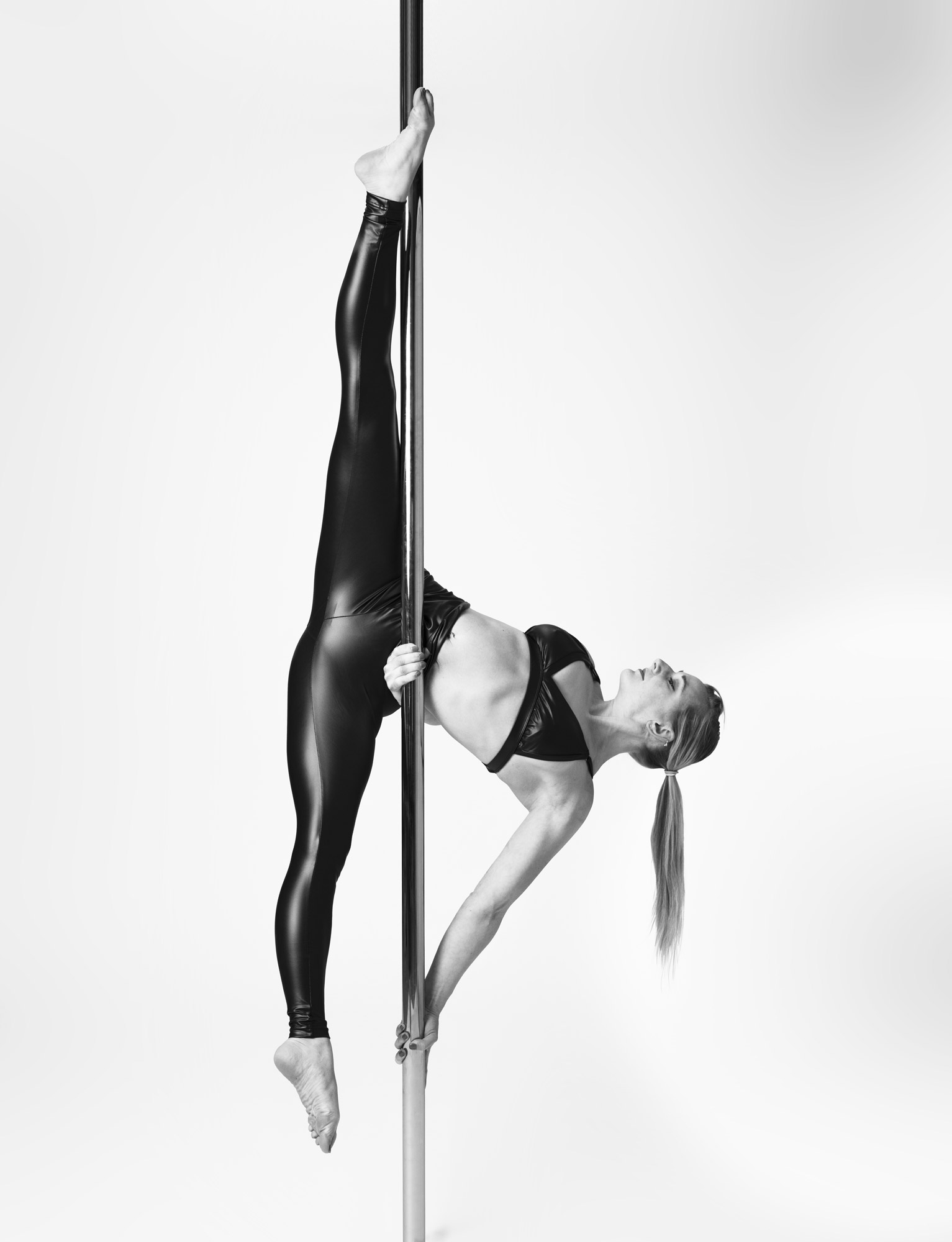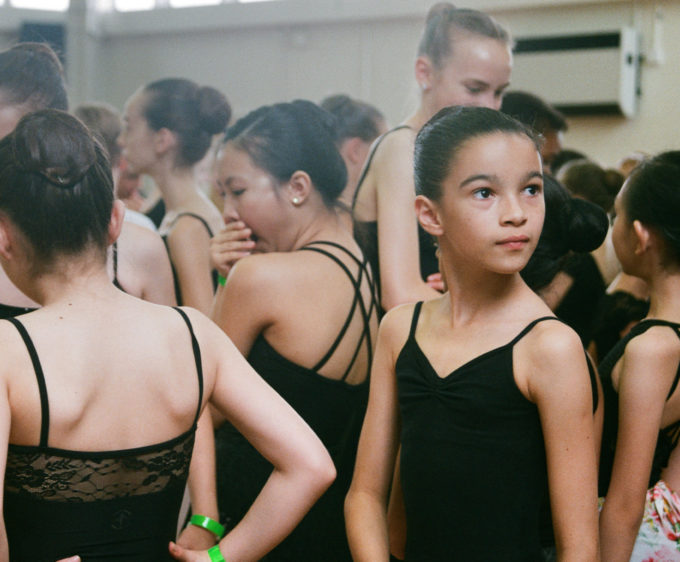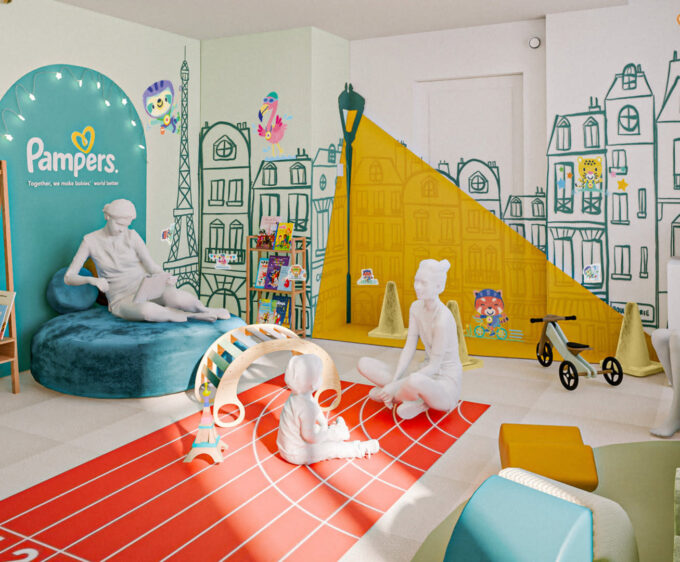
Bend It Like Kate
Is there nothing Bendy Kate can't do? We meet and film the pole professional to discuss her business, motherhood, and encouraging new talent to this skilled and tough sport
By Precious Adesina
Photography by Heiko Prigge
When Kate Czepulkowski, known professionally as Bendy Kate, first heard of pole fitness in 2009, she didn’t expect it to change the course of her life. “I immediately thought it sounded really cool,” the 31-year-old tells Glorious about finding out about the performance sport while studying at the University of West of England in Bristol. At the time, Kate was an ex-gymnast so she knew she had the skills to do well at pole. “I had it drilled in me that if you do a sport, you compete in it.” A philosophy she says was down to having an athletic family; her mother was a Great Britain trampolining champion at the age of 18. Today, Kate has several world titles including Pole Art France Champion in 2017, IPC Pole Fit Champion in 2015 – which is considered one of the highest level competitions in the pole dance industry – and World Pole Dance Champion in 2014.
For many sportspeople, one of the greatest perks is travelling, something Kate initially enjoyed but eventually grew tired of. “I wanted to settle down a bit more since I’d already seen a lot of the world,” she says. “In that respect, the pandemic was actually quite a nice thing for me as it gave me the chance to set up my studio, which I’d been dreaming of for the last 10 years.” Her initial thought was to try for a baby, but she changed her mind about the timing to focus on The Bendy Studio. “I only have one ovary, so I had it in my head that it would take me at least two years to conceive,” she says over Zoom, while smiling at her daughter Esme who is crying at the sight of a new face on the computer screen, “but I was actually already pregnant by then.”
A day after our interview, Kate gets in touch to say she was initially nervous about her photoshoot and film for Glorious, having only given birth four months ago. But, despite how it may sound, Kate’s anxiety was more about her ability than her figure. “I definitely have a different body now and I’m totally happy about that. I don’t mind having a bit of a belly or bigger boobs, hips or legs,” she tells us. “I ended up feeling really happy and proud of what my body was capable of in such a short space of time,” she says.

Despite Kate’s worries, she had a smooth recovery postpartum, which she believes is as a result of continuing to train during her pregnancy. “I did (and still do) Pilates almost every day which gives me the foundation I need to be able to pole dance, teach and even lift my body upside down,” she explains, adding that this is not reflective of anyone else’s pregnancy or even her future ones. “I could have another pregnancy and have a completely different recovery or birth. You never know how lucky you’re going to be.”
While, at first glance, Kate’s story sounds rosy, pregnant professional athletes are often treated poorly and she isn’t exempt. In December last year, the Canadian newspaper the National Post reported on the resentment Olympic athletes felt in learning that pregnancy is often categorised as an ‘injury’ in their contracts. In a New York Times article in mid-2019, several US runners took part in a video where they accused one of the world’s biggest sporting brands of discriminating against female athletes. In the video, six-time national champion Alysia Montaño said that, when she told Nike that she was pregnant, representatives said they would stop paying her and pause her sponsorship contract.
ACROBATIC

For Kate, it was online comments that she found hardest to deal with. After posting pictures and videos of her training while pregnant on Instagram, commenters accused her of not considering the wellbeing of her baby. She became increasingly worried that she’d be blamed for any complications that could potentially occur during her pregnancy, even though she knew her job wouldn’t be the reason for it. “As if a mother would ever set out to intentionally hurt her child,” she says. “That doesn’t happen. Why would you want to hurt your growing baby?” She adds that people often see pregnant people as fragile without considering who they were before pregnancy. “Being pregnant is so amazing and being able to feel like yourself in that condition is even better,” she says, noting that pole allowed her to feel normal. “[Pregnancy] doesn’t take away from the fact that you are an athlete. You are still safe to continue what you’re doing, with adaptations.”

ENCOURAGING

Even outside of pregnancy, like any sport, pole fitness requires an athlete’s body to stay in top form. Kate had an injury in 2017 that made her job more challenging. “I’ve got a family history of shoulder problems,” she says. She had a full rotator cuff repair, a surgery used to mend a tear in one of the tendons that links your upper arm bone to particular muscles. “I carried on working because when you’re self-employed, you just do what you’ve got to do,” she says. She also found the injury painful even after surgery. “I travelled with an assistant who would demonstrate and teach my classes for me. I didn’t perform until I was three months post-op and I was mainly dancing, not doing tricks because shoulder surgery has a really slow recovery time.”

Getting better after her surgery took a lot of hard work. “I did loads of rehab,” Kate says. “After four months, I could pretend that I’d never had the surgery [while performing]. So you wouldn’t necessarily know if you didn’t go close to my arm to see the scars.” She even successfully auditioned for the world’s largest contemporary circus producer in the world, Cirque Du Soleil, around that time. “I don’t think they would’ve noticed that I’d had a major operation.”
Kate’s passion for pole has also made her into a multifaceted businesswoman. Outside of running her studio and being a highly recognised pole champion, she created the Bendy Brand almost seven years ago, initially as a platform to sell her books – she currently has three separate ones on flexibility, handstands and injury prevention. “I didn’t want to sell them as just Bendy Kate products, I wanted to become a brand but I wasn’t sure how to do that.” Today, the Bendy Brand is a successful company that also offers downloadable fitness videos for home workouts, clothes and yoga supplies.


The clothing line specifically came out of necessity as pole dancers often have trouble finding appropriate sportswear for their specific needs. “I used to buy things on eBay. There weren’t really pole brands or pole shorts when I started so we’d just wear big pants,” she says, laughing before going on to explain that the best designers of fitness gear are often involved in the sport they’re making it for. “I’d worn so many different pieces for pole, so I had some ideas of how I could make functional clothing,” she says. Her main goal was creating items that would keep pole dancers uninjured, warm and comfortable throughout performances. “We grip the metal equipment using our skin so we have to have different points of contact to be safe while performing moves, for example.”

Throughout our conversation, Kate uses the terms ‘pole dance’ and ‘pole fitness’ interchangeably despite the preconceptions pole dancing has. It has previously been considered an ‘inappropriate’ activity due to its relationship with strip clubs. This initially resulted in the sport having strict dress codes and rules at competitions though Kate says they have relaxed over time. “I think I was so young and naive. When I first heard of pole, I didn’t even think of strip clubs or anything like that,” she says, noting that she was aware pole could be sexy, “but not in a negative way.” “I used to be embarrassed to say pole dancer [because of its connotations], but looking back there’s absolutely nothing wrong with sex work. I think it’s important not to take pole away from one of its origins. Stripping is hard work, it’s a job and it takes skill.”
Regardless of what a person thinks of pole dancing, when they take Kate’s classes, they are usually hoping to learn how to master Kate’s acrobatic and dance skills. “I think my style is very transitional, so I focus not only on the moves but also the bits in between,” she says. “It helps to have a rounded repertoire. I’m flexible, strong and I can dance… I think being nice, friendly and helpful goes a long way too.”










